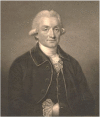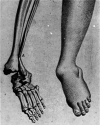Why is William Sharp's name forgotten when his novel method for treating fractures of the Ankle is still used today?
- PMID: 35317689
- PMCID: PMC10176749
- DOI: 10.1177/09677720221082103
Why is William Sharp's name forgotten when his novel method for treating fractures of the Ankle is still used today?
Abstract
In 1837 Guillaume von Dupuytren (1777-1835) wrote that the innovative method of reducing an ankle fracture by relaxing the calf muscles was due to both William Sharp (1729-1810) and Percivall Pott (1714-1788). While history records the many surgical achievements of Percivall Pott, little is known of William Sharp's contribution. He is probably best known as one of a remarkable family portrayed by Johan Zoffany (1733-1810) and exhibited at the Royal Academy in 1781. We review William Sharp's career and contribution as a surgeon to the treatment of fracture/dislocations of the ankle and ask why his concept is not better known today.
Keywords: Fracture /Dislocations of Ankle; Granville Sharp. Johan Zoffany; Guillaume von Dupurtren; Percivall Pott; William Sharp.
Conflict of interest statement
The author(s) declared no potential conflicts of interest with respect to the research, authorship, and/or publication of this article.
Figures




References
-
- Dupuytren G. On the Injuries and Diseases of Bones, translated by F le Gros Clark. London: Sydenham Society. 1867ch 1, 1.
-
- Hughes SPF. An Historical Review of Fractures Involving the Ankle Joint. Mayo Clinic Proceedings 1975;50: 611– 614. - PubMed
-
- Grant H. The Good Sharps; The Brothers and Sisters who Remade Their World. London: Chatto & Windus; 2020, 165.
-
- Aspinall A. ed The Later Correspondence of George III, 1798–1801. Cambridge: Cambridge University Press, 1967, 3, 93.
-
- Stigler SM. Stigler’s law of eponymy. Transactions of the New York Academy of Sciences 1980; 39: 147– 158.
Publication types
MeSH terms
LinkOut - more resources
Full Text Sources

